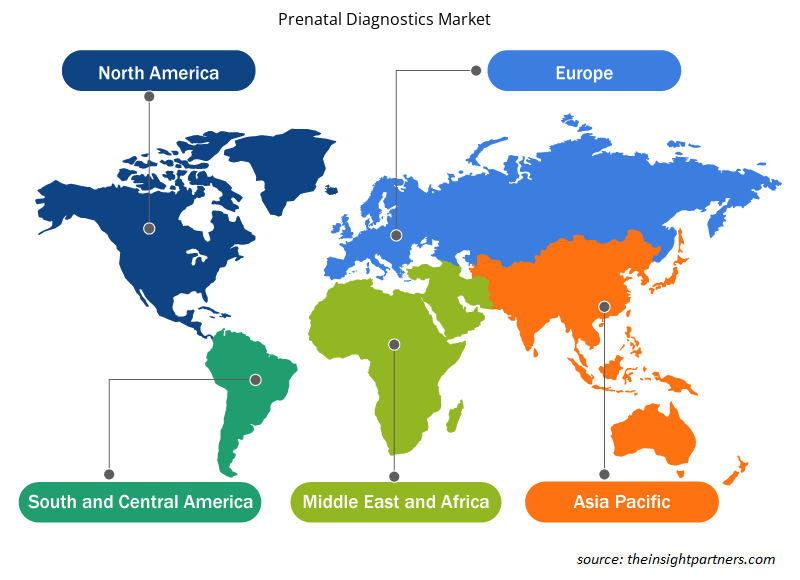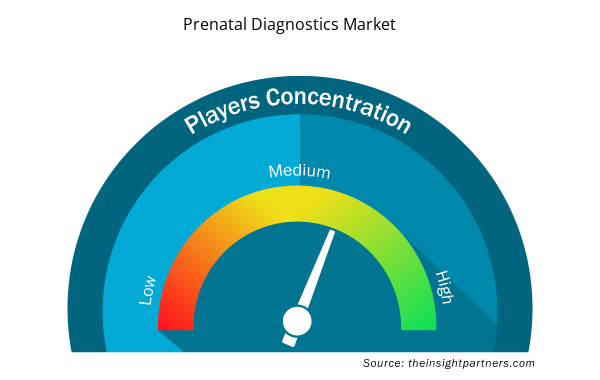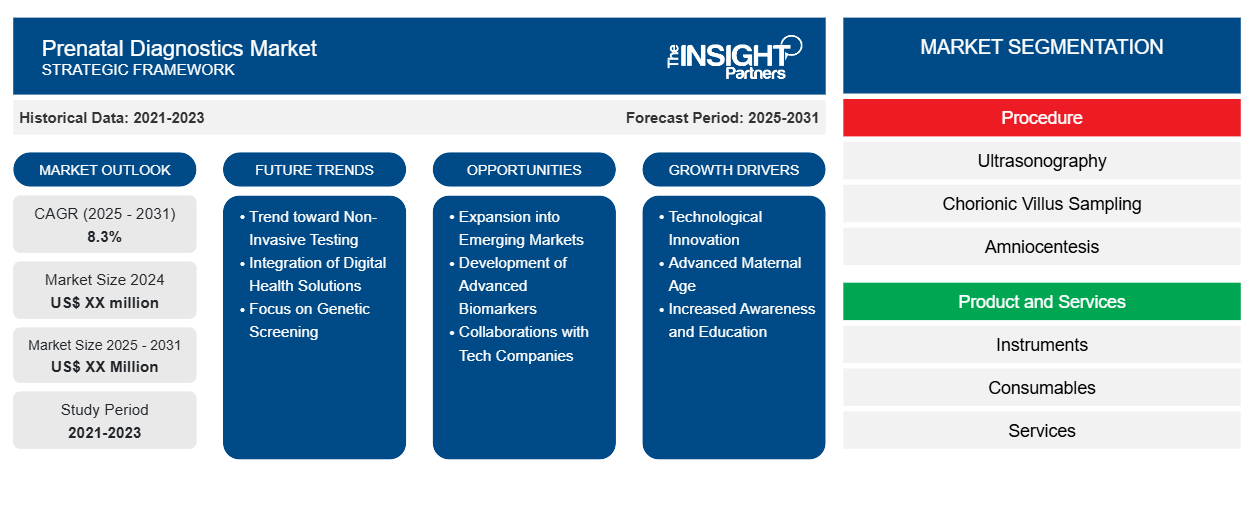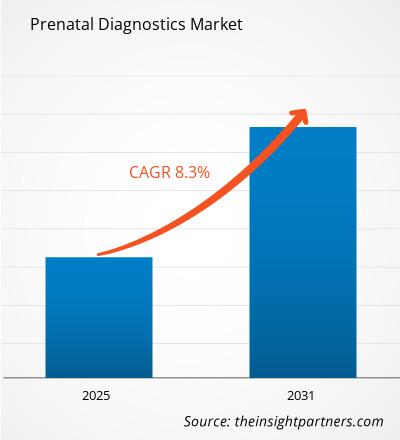Si prevede che il mercato della diagnostica prenatale registrerà un CAGR dell'8,3% dal 2024 al 2031, con una dimensione di mercato in espansione da XX milioni di dollari nel 2024 a XX milioni di dollari entro il 2031.
Il report è segmentato per Procedura (Ultrasonografia, Prelievo dei villi coriali, Amniocentesi, Prelievo percutaneo del sangue ombelicale, Diagnosi genetica preimpianto); Prodotto e servizi (Strumenti, Materiali di consumo, Servizi); Applicazione (Anomalia cromosomica, Disordini genetici); Utente finale (Ospedali, Laboratori diagnostici). L'analisi globale è ulteriormente suddivisa a livello regionale e nei principali paesi. Il report offre il valore in USD per l'analisi e i segmenti di cui sopra.
Scopo del rapporto
Il report Prenatal Diagnostics Market di The Insight Partners mira a descrivere il panorama attuale e la crescita futura, i principali fattori trainanti, le sfide e le opportunità. Ciò fornirà spunti a vari stakeholder aziendali, come:
- Fornitori/produttori di tecnologia: per comprendere le dinamiche di mercato in evoluzione e conoscere le potenziali opportunità di crescita, consentendo loro di prendere decisioni strategiche informate.
- Investitori: condurre un'analisi completa delle tendenze in merito al tasso di crescita del mercato, alle proiezioni finanziarie del mercato e alle opportunità esistenti lungo la catena del valore.
- Enti di regolamentazione: regolamentano le politiche e le attività di controllo sul mercato allo scopo di ridurre al minimo gli abusi, preservare la fiducia degli investitori e sostenere l'integrità e la stabilità del mercato.
Segmentazione del mercato della diagnostica prenatale
Procedura
- Ultrasonografia
- Campionamento dei villi coriali
- Amniocentesi
- Prelievo percutaneo di sangue ombelicale
- Diagnosi genetica preimpianto
Prodotti e servizi
- Strumenti
- Materiali di consumo
- Servizi
Applicazione
- Anomalia cromosomica
- Malattie genetiche
Utente finale
- Ospedali
- Laboratori Diagnostici
Personalizza questo report in base alle tue esigenze
Riceverai la personalizzazione gratuita di qualsiasi report, comprese parti di questo report, o analisi a livello nazionale, pacchetto dati Excel, oltre a usufruire di grandi offerte e sconti per start-up e università
- Scopri le principali tendenze di mercato in questo rapporto.Questo campione GRATUITO includerà analisi di dati che spaziano dalle tendenze di mercato alle stime e alle previsioni.
Fattori trainanti della crescita del mercato della diagnostica prenatale
- Innovazione tecnologica: nuove tecnologie, come i test prenatali non invasivi, o NIPT, e altre tecnologie di imaging avanzate, stanno cambiando radicalmente il campo di gioco. Le tecnologie qui utilizzate cercano di fornire diagnosi più sicure e accurate sulla salute del feto, consentendo così di evitare del tutto i rischi derivanti da procedure invasive. Le capacità diagnostiche avanzate, tra cui la capacità di fornire interventi tempestivi, promuovono una domanda crescente di soluzioni di test prenatali più avanzate da parte dei futuri genitori.
- Età materna avanzata: la società si è evoluta e la maggior parte delle donne preferisce partorire in età avanzata, il che le espone effettivamente a un rischio maggiore di disturbi genetici e altre complicazioni durante la gravidanza. Pertanto, questo fattore richiede ulteriori screening e diagnosi prenatali completi perché le donne più anziane cercano di prendere il controllo e garantire gravidanze sane. In realtà, sono i rischi maggiori che costringono la coppia a investire in questi nuovi servizi di assistenza prenatale.
- Maggiore consapevolezza e istruzione: una maggiore consapevolezza dell'importanza della diagnosi prenatale sta cambiando il comportamento dei consumatori. Di conseguenza, l'aumento dell'attività educativa e dell'accessibilità alla conoscenza consente ai futuri genitori di cercare scelte informate in materia di salute sia per la madre che per il bambino. Questo cambiamento verso servizi sanitari proattivi sta guidando il fenomeno dei servizi di test prenatali in cui i genitori cercano la diagnosi precoce e la prevenzione di possibili problemi.
Tendenze future del mercato della diagnostica prenatale
- Tendenza verso i test non invasivi: c'è una tendenza verso i test prenatali non invasivi che è ben noto per fornire valutazioni sicure e accurate delle condizioni fetali senza i rischi delle procedure invasive stesse. Tale tendenza ha davvero preso piede nel corso degli anni con i progressi della tecnologia e la consapevolezza tra i futuri genitori, aumentando così la domanda di NIPT e rendendolo un approccio iniziale appropriato per la maggior parte dei test prenatali.
- Integrazione di soluzioni di salute digitale: con l'integrazione di applicazioni di telemedicina e salute mobile, si apre una porta all'introduzione di nuove tecnologie di salute digitale nella diagnostica prenatale. I risultati dei test prenatali e delle consultazioni a distanza consentiranno miglioramenti per aumentare la comodità e il coinvolgimento del paziente. Fa parte di una tendenza emergente di domanda di soluzioni di salute personalizzate e accessibili nella diagnostica prenatale tra i futuri genitori.
- Focus sullo screening genetico: c'è una tendenza in espansione dello screening genetico nel mercato della diagnostica prenatale. In questo contesto, con l'avanzare delle conoscenze e il crescente riconoscimento delle condizioni ereditarie, i futuri genitori cercano le valutazioni più approfondite della genetica per accertare i rischi in qualsiasi fase iniziale. Questa tendenza alla fine guiderà la creazione di soluzioni di test più mirate, la collaborazione tra operatori sanitari e consulenti genetici e, di conseguenza, una migliore erogazione delle cure.
Opportunità di mercato per la diagnostica prenatale
- Espansione nei mercati emergenti: i mercati in crescita rappresentano una grande opportunità per il settore della diagnostica prenatale. Con lo sviluppo dell'infrastruttura sanitaria e la crescente consapevolezza dell'assistenza prenatale, ciò aumenta la domanda di tecnologie diagnostiche più avanzate. Piattaforme di test a basso costo e istruzione in aree finora con scarse risorse possono quindi essere capitalizzate per ottenere un maggiore accesso ai servizi prenatali.
- Sviluppo di biomarcatori avanzati: scoperta e identificazione di nuovi biomarcatori I biomarcatori per la diagnosi prenatale sono un'area che assisterà a 'svolte' innovative. I progressi all'avanguardia sia nella genomica che nella proteomica saranno in grado di aprire strade che porteranno allo sviluppo di test molto sensibili e predittivi su un'ampia gamma di condizioni. Ecco come questa possibile strada verso la medicina di precisione migliora la valutazione della salute fetale, portando con sé un modo di personalizzare l'assistenza prenatale per i genitori attenti al benessere.
- Collaborazioni con aziende tecnologiche: le aziende che si occupano di tecnologie collaboreranno con altre per accelerare l'innovazione nella diagnostica prenatale. C'è un'integrazione di intelligenza artificiale e apprendimento automatico nel software diagnostico, accelerando l'analisi dei dati e la valutazione del rischio. Ciò potrebbe aumentare l'offerta di prodotti, facilitare piattaforme più intuitive e facili da usare e cambiare il volto dell'assistenza prenatale per i futuri genitori.
Approfondimenti regionali sul mercato della diagnostica prenatale
Le tendenze regionali e i fattori che influenzano il mercato della diagnostica prenatale durante il periodo di previsione sono stati ampiamente spiegati dagli analisti di Insight Partners. Questa sezione discute anche i segmenti e la geografia del mercato della diagnostica prenatale in Nord America, Europa, Asia Pacifico, Medio Oriente e Africa e America meridionale e centrale.

- Ottieni i dati specifici regionali per il mercato della diagnostica prenatale
Ambito del rapporto di mercato sulla diagnostica prenatale
| Attributo del report | Dettagli |
|---|---|
| Dimensioni del mercato nel 2024 | XX milioni di dollari USA |
| Dimensioni del mercato entro il 2031 | XX milioni di dollari USA |
| CAGR globale (2025 - 2031) | 8,3% |
| Dati storici | 2021-2023 |
| Periodo di previsione | 2025-2031 |
| Segmenti coperti | Per procedura
|
| Regioni e Paesi coperti | America del Nord
|
| Leader di mercato e profili aziendali chiave |
|
Densità degli attori del mercato della diagnostica prenatale: comprendere il suo impatto sulle dinamiche aziendali
Il mercato della diagnostica prenatale sta crescendo rapidamente, spinto dalla crescente domanda degli utenti finali dovuta a fattori quali l'evoluzione delle preferenze dei consumatori, i progressi tecnologici e una maggiore consapevolezza dei benefici del prodotto. Con l'aumento della domanda, le aziende stanno ampliando le loro offerte, innovando per soddisfare le esigenze dei consumatori e capitalizzando sulle tendenze emergenti, il che alimenta ulteriormente la crescita del mercato.
La densità degli operatori di mercato si riferisce alla distribuzione di aziende o società che operano in un particolare mercato o settore. Indica quanti concorrenti (operatori di mercato) sono presenti in un dato spazio di mercato in relazione alle sue dimensioni o al valore di mercato totale.
Le principali aziende che operano nel mercato della diagnostica prenatale sono:
- GE Healthcare (Società elettrica generale)
- Thermo Fisher Scientific, Inc.
- Illumina, Inc.
- Società anonima F. Hoffman-La Roche Ltd.
- Istituto di genomica di Pechino
Disclaimer : le aziende elencate sopra non sono classificate secondo un ordine particolare.

- Ottieni una panoramica dei principali attori del mercato della diagnostica prenatale
Punti di forza chiave
- Copertura completa: il rapporto esamina in modo completo i prodotti, i servizi, le tipologie e gli utenti finali del mercato della diagnostica prenatale, fornendo una panoramica olistica.
- Analisi degli esperti: il rapporto è compilato sulla base della conoscenza approfondita di esperti e analisti del settore.
- Informazioni aggiornate: il rapporto garantisce la pertinenza aziendale grazie alla copertura di informazioni recenti e tendenze nei dati.
- Opzioni di personalizzazione: questo report può essere personalizzato per soddisfare le esigenze specifiche del cliente e adattarsi in modo appropriato alle strategie aziendali.
Il rapporto di ricerca sul mercato della diagnostica prenatale può, quindi, aiutare a guidare il percorso di decodificazione e comprensione dello scenario del settore e delle prospettive di crescita. Sebbene possano esserci alcune preoccupazioni valide, i vantaggi complessivi di questo rapporto tendono a superare gli svantaggi.
- Analisi storica (2 anni), anno base, previsione (7 anni) con CAGR
- Analisi PEST e SWOT
- Valore/volume delle dimensioni del mercato - Globale, regionale, nazionale
- Industria e panorama competitivo
- Set di dati Excel



Report Coverage
Revenue forecast, Company Analysis, Industry landscape, Growth factors, and Trends

Segment Covered
This text is related
to segments covered.

Regional Scope
North America, Europe, Asia Pacific, Middle East & Africa, South & Central America

Country Scope
This text is related
to country scope.
Domande frequenti
Asia Pacific is estimated to grow at the highest CAGR over the forecast year (2023 - 2031)
The North America region accounts for highest revenue share prenatal diagnostics market
The final report will duly include market size and projection estimates for all the segments from 2021 to 2031, along with a revenue share and compound annual growth rate (%) for the regional
/
country-wise market wherein 2021-2022 are the historic years, 2023 is considered to be the base year, and the forecast will be provided till 2031, along with CAGR (%)
The market is expected to grow at a CAGR of 8.3%
advanced maternal age and increased awareness and education about prenatal diagnostics are the major factors boosting the prenatal diagnostics market growth
GE Healthcare (General Electric Company), Thermo Fisher Scientific, Inc., Illumina, Inc., F. Hoffman-La Roche Ltd., Beijing Genomics Institute, Agilent Technologies, Inc., Perkinelmer, Inc., Hologic, Inc., Natera, Inc., Quest Diagnostics, Inc. are the some of the key market players operating in the prenatal diagnostics market
Trends and growth analysis reports related to Life Sciences : READ MORE..
1. GE Healthcare (General Electric Company)2. Thermo Fisher Scientific, Inc.3. Illumina, Inc.4. F. Hoffman-La Roche Ltd.5. Beijing Genomics Institute6. Agilent Technologies, Inc.7. Perkinelmer, Inc.8. Hologic, Inc.9. Natera, Inc.10. Quest Diagnostics, Inc.
The Insight Partners performs research in 4 major stages: Data Collection & Secondary Research, Primary Research, Data Analysis and Data Triangulation & Final Review.
- Data Collection and Secondary Research:
As a market research and consulting firm operating from a decade, we have published and advised several client across the globe. First step for any study will start with an assessment of currently available data and insights from existing reports. Further, historical and current market information is collected from Investor Presentations, Annual Reports, SEC Filings, etc., and other information related to company’s performance and market positioning are gathered from Paid Databases (Factiva, Hoovers, and Reuters) and various other publications available in public domain.
Several associations trade associates, technical forums, institutes, societies and organization are accessed to gain technical as well as market related insights through their publications such as research papers, blogs and press releases related to the studies are referred to get cues about the market. Further, white papers, journals, magazines, and other news articles published in last 3 years are scrutinized and analyzed to understand the current market trends.
- Primary Research:
The primarily interview analysis comprise of data obtained from industry participants interview and answers to survey questions gathered by in-house primary team.
For primary research, interviews are conducted with industry experts/CEOs/Marketing Managers/VPs/Subject Matter Experts from both demand and supply side to get a 360-degree view of the market. The primary team conducts several interviews based on the complexity of the markets to understand the various market trends and dynamics which makes research more credible and precise.
A typical research interview fulfils the following functions:
- Provides first-hand information on the market size, market trends, growth trends, competitive landscape, and outlook
- Validates and strengthens in-house secondary research findings
- Develops the analysis team’s expertise and market understanding
Primary research involves email interactions and telephone interviews for each market, category, segment, and sub-segment across geographies. The participants who typically take part in such a process include, but are not limited to:
- Industry participants: VPs, business development managers, market intelligence managers and national sales managers
- Outside experts: Valuation experts, research analysts and key opinion leaders specializing in the electronics and semiconductor industry.
Below is the breakup of our primary respondents by company, designation, and region:

Once we receive the confirmation from primary research sources or primary respondents, we finalize the base year market estimation and forecast the data as per the macroeconomic and microeconomic factors assessed during data collection.
- Data Analysis:
Once data is validated through both secondary as well as primary respondents, we finalize the market estimations by hypothesis formulation and factor analysis at regional and country level.
- Macro-Economic Factor Analysis:
We analyse macroeconomic indicators such the gross domestic product (GDP), increase in the demand for goods and services across industries, technological advancement, regional economic growth, governmental policies, the influence of COVID-19, PEST analysis, and other aspects. This analysis aids in setting benchmarks for various nations/regions and approximating market splits. Additionally, the general trend of the aforementioned components aid in determining the market's development possibilities.
- Country Level Data:
Various factors that are especially aligned to the country are taken into account to determine the market size for a certain area and country, including the presence of vendors, such as headquarters and offices, the country's GDP, demand patterns, and industry growth. To comprehend the market dynamics for the nation, a number of growth variables, inhibitors, application areas, and current market trends are researched. The aforementioned elements aid in determining the country's overall market's growth potential.
- Company Profile:
The “Table of Contents” is formulated by listing and analyzing more than 25 - 30 companies operating in the market ecosystem across geographies. However, we profile only 10 companies as a standard practice in our syndicate reports. These 10 companies comprise leading, emerging, and regional players. Nonetheless, our analysis is not restricted to the 10 listed companies, we also analyze other companies present in the market to develop a holistic view and understand the prevailing trends. The “Company Profiles” section in the report covers key facts, business description, products & services, financial information, SWOT analysis, and key developments. The financial information presented is extracted from the annual reports and official documents of the publicly listed companies. Upon collecting the information for the sections of respective companies, we verify them via various primary sources and then compile the data in respective company profiles. The company level information helps us in deriving the base number as well as in forecasting the market size.
- Developing Base Number:
Aggregation of sales statistics (2020-2022) and macro-economic factor, and other secondary and primary research insights are utilized to arrive at base number and related market shares for 2022. The data gaps are identified in this step and relevant market data is analyzed, collected from paid primary interviews or databases. On finalizing the base year market size, forecasts are developed on the basis of macro-economic, industry and market growth factors and company level analysis.
- Data Triangulation and Final Review:
The market findings and base year market size calculations are validated from supply as well as demand side. Demand side validations are based on macro-economic factor analysis and benchmarks for respective regions and countries. In case of supply side validations, revenues of major companies are estimated (in case not available) based on industry benchmark, approximate number of employees, product portfolio, and primary interviews revenues are gathered. Further revenue from target product/service segment is assessed to avoid overshooting of market statistics. In case of heavy deviations between supply and demand side values, all thes steps are repeated to achieve synchronization.
We follow an iterative model, wherein we share our research findings with Subject Matter Experts (SME’s) and Key Opinion Leaders (KOLs) until consensus view of the market is not formulated – this model negates any drastic deviation in the opinions of experts. Only validated and universally acceptable research findings are quoted in our reports.
We have important check points that we use to validate our research findings – which we call – data triangulation, where we validate the information, we generate from secondary sources with primary interviews and then we re-validate with our internal data bases and Subject matter experts. This comprehensive model enables us to deliver high quality, reliable data in shortest possible time.


 Ottieni un campione gratuito per questo repot
Ottieni un campione gratuito per questo repot